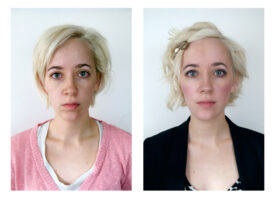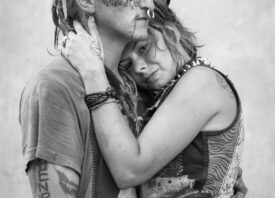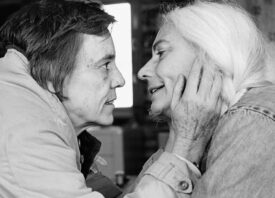Search this site
A Chance of Love: One Woman’s Portraits of Men She Met on Tinder



“I originally planned to finish the project when I fell in love,” the photographer Mel McVeigh tells me. “That was my plan. But it didn’t happen.” A Chance of Love is her exploration of modern love, made in collaboration with men she met through Tinder. Each of the men featured in the book responded to a question posed on the artist’s dating profile: Can I take your portrait?
The initial inspiration for the project was born out of necessity: while working at a photo retreat and masterclass in a remote part of France, McVeigh had difficulty finding people to sit for portraits. The masterclass was led by the photographer Claudine Doury, who brought up the possibility of finding people through Tinder.
The first meeting took McVeigh on a journey of 100 kilometers; in many ways, it was a shot in the dark. After the portrait session, however, they went on a date to see the oyster farms nearby and became fast friends (though the romantic “spark” wasn’t there).
McVeigh had used Tinder on and off for around five years, and she continued to use it as normal—for dating—throughout the duration of the project. She only “swiped” on people who genuinely sparked her interest. The priority was the connection; the portrait always came second.
She created most of the portraits within about thirty minutes of meeting her dates, having spoken with them on the phone previously to get acquainted. In some cases, if there was chemistry, they chose to go on a date (or a few) first before sitting down to do the portrait.
Some of the men she dated but didn’t end up photographing after all. If they didn’t ask about that question on her profile—Can I take your portrait?—then she didn’t bring it up. Some people brought it up but then never showed up—that is, they “ghosted.” But those who agreed to sit for a portrait and who went through with it found it was the perfect conversation starter.
McVeigh found some were in creative fields or chose to live as digital nomads—so they were naturally curious people. “Everyone said yes for a few reasons,” the artist says. “Many had never had a portrait taken, so the process intrigued them. There was a giddiness to the idea. It was something different from just going out for a drink. For them and me… there was also a chance of love.”
McVeigh works in tech, and the project also sparked questions for her about dating app algorithms: what does it mean, she wondered, to entrust technology to make such meaningful choices for us? While working on her Tinder portraits, she experimented with her profile and preferences to see how the recommendations changed based on her behavior and perceived patterns.
“As we talk more about AI and Machine Learning, people need to understand that apps like these work on simple mathematics,” the artist explains. “They look for medians and averages. If you like ‘this type of person,’ then it will show you more people like this. This is very simplistic, and you lose sight of serendipity and chance. It took a lot of playing with the algorithm to change the type of people it presented to me.”
After introducing a bit of serendipity and chance into the equation herself, McVeigh came away with several friendships. The book was made collaboratively with the men featured: one helped with the final edit, and another contributed a poem. McVeigh included her own poetry as well, with lines inspired by notes she jotted down after dates.
The experience was a vulnerable one, and McVeigh always felt nervous before a photoshoot. So did the men. “You have exposed me,” one of her dates told her. “This is something technology will never understand.” This man, a cinematographer, asked her to sit for a portrait herself. She agreed: “When he took my photo, all I can say is it was terrifying. I was not in control and had to trust him.”
And trust counted for everything. The men had no way of knowing how they would be represented, or whether or not it was part of some bizarre type of scam, so it was a leap of faith. For the artist, she was venturing into someone else’s home without knowing what to expect. When photographing men in their bedrooms, she made it very clear that it would be for the photograph only—“no more or less.”
Beyond the portraits of her Tinder dates, A Chance of Love also includes the unedited WhatsApp conversations between McVeigh and her dates; names are not included, and she got permission from everyone included. “It is literally what we talked about: the banal, the planning, sexting, all of it,” she says.
McVeigh did not fall in love, despite her original plan for the project. “There was one who I started to fall in love with,” she tells me. “But the ending was not happy.” After she took his portrait, they never saw one another again. She doesn’t know why it didn’t work out, but it didn’t. As is often the case, they simply moved on.
A Chance of Love will be on view at BSMT Space in London from May 10th through 14th. The book will be published on the 10th; get your copy here, and follow the artist on Instagram at @melmcveighphoto.





Looking for more Tinder portraits? Read these stories next:
• Nude Portraits in Which the Photographer Himself Is Unclothed
• ‘Tinderella’: An NYC Photographer and Her Portraits of Tinder Dates


